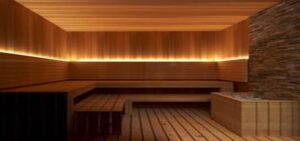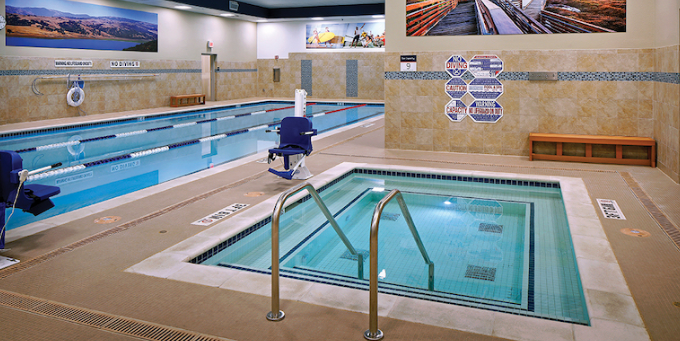It’s possible to turn your home restroom into a private spa despite a busy schedule or an improper work-life balance. There is a solution that fits every taste and limit, with options ranging from spending up to $15,000 on a more costly steam shower installation to transforming your ordinary shower into an infrared spa for about $2000.
Alternatively, closing your bathroom area to contain moist air may create a quick and efficient relaxation experience for a less complex and more affordable steam room experience. Examine each of the requirements, benefits, drawbacks, and expenses related to every alternative to choose which one is best for your at-home spa.
Table of Contents
How to use your shower as a sauna?
Turn on the hot water and let the bathroom fill with steam to begin turning your shower into a temporary bathhouse. Shut every window and door to keep the steam inside. bring some eucalyptus seed oil to the shower floor or hang some rosemary branches from the showerhead to bring some fresh scent to the sauna-like atmosphere.
To open your pores and encourage relaxation, sit or stand in the steam for ten to fifteen minutes. To prevent burns, always drink plenty of water and pay attention to the hot water’s level. Enjoy the tranquilizing effects of your homemade spa in the comfort of your lavatory!
Can you turn your shower into a sauna?

Although they may be set up indoors or outdoors, infrared and electric spas work best indoors. The bathroom could seem like the ideal location for your new spa installation, especially because it’s suggested to take a shower both before and after spa sessions. Even in a location with water and steam already installed, building a spa might be an expensive project. The kind of sauna (constructed or custom-built), any required space changes, and professional service costs all affect the overall cost.
Although installing a spa may be done yourself, it’s best to hire a plumber to construct a steam room and an electrician to wire the heating system for safety. When everything is said and done, the price of an indoor home sauna or steam room might vary from $3,000 to over $15,000, based upon additional services. A permanent bath may add value to your house, even at its original cost.
Tips for converting a regular shower into an infrared sauna
An infrared spa allows for location independence; all that is needed is respect for its specific needs. Similar requirements apply to steam showers, where plastic materials must be avoided in favor of sufficient separation and heat-resistant frames. A shower-to-sauna conversion system designed specifically for this use costs about $2,000. This package contains:
- An infrared bath panel.
- Spa shutters and poles.
- A wooden bath stool includes a platform for the bath panel installation.
Tips to convert a regular shower into a steam room

Not only is it possible to transform a regular shower into a steam room, but it’s also often spoken of as the most sensible choice when comparing bathhouse substitutes. You don’t need expensive experts or specific equipment to make it happen. The main component in this process is steam, which is wet heat or evaporated water.
The biggest worry is the possibility of mold development as a result of steam buildup. Make sure your restroom and the area around it have sufficient airflow to release the steam after a session to reduce this danger. As an insider, it’s very easy to transform a regular shower space into a simple steam room.
- Use a towel to plug any gaps where air could pass in or out.
- Activate the hot water taps in the bathtub and sink.
- Give the steam time to build up.
- Locate a warm area, like a bathroom, away from the hot water that is flowing.
- Enjoy yourself and let your hair down.
How to change a regular shower into a steam shower

A steam shower has to meet a few criteria, the most important of which is that it must be sealed and not exceed eight feet. To fully enjoy the advantages of a steam room, a regular shower is typically modified into a steam shower. Using an electrician and a plumber for this modification is highly advised.
To create steam through the steam bath head, the plumber must install water lines between the shower and the generator. The water is heated to 120°F by the generator. The electrician finishes connecting the steam engine and control panel; in the meantime, users may only turn on the equipment by pressing the enabling button. The following is needed to set up a steam shower:
- A closed space with a bent roof eight feet high.
- A boiler that produces steam.
- A seat.
The present specifications of your bathroom will determine how much work is required for installation. Paint that resists mold growth and suitable insulation is crucial, as steam raises the possibility of growth. Choosing a smaller bathroom might result in increased heating efficiency and extended heat retention. The installation is expected to cost between $5,000 and $12,000, most of which is linked to the steam generator, which costs between $1,000 and $4,000.
Sauna Shower Kits:
- You may buy constructed spa showers using these kits.
- When installing a kit, make sure the installation area meets the requirements.
- Make sure the plumbing and electrical fit the specifications for the spa.
- Sets for hot showers range in price from $3,000 to $4,500.
Sauna Shower Combos:
- A spa-shower combination combines the benefits of a steam room and sauna with the characteristics of a regular shower.
- It provides an all-inclusive spa experience, taking the place of a standard shower.
- A spa-shower combo may cost anywhere from $4,000 to $15,000, depending on upgrades and modifications.
- When choosing a spa-shower combo, take into account facilities like seats, scent therapy, clarity, massage jets, and more.
Adding a sauna in the bathroom
Adding a sauna to your bathroom can help you with your post-sauna routine, especially when it comes to washing off. The amount of space in your bathroom that you have will affect the size of the spa you choose. You will require a power source for your sauna, no matter what kind you select. Some spas can use an infrared heater that runs on 120 volts, but dry spas usually need a 220-volt electrical input for the heater.
Benefits and drawbacks of using your shower as a sauna
There are some benefits and drawbacks to using your shower as a sauna:
Benefits:
- Convenience: Converting your shower into a heated spa allows you to take advantage of thermal sessions without needing additional space or construction.
- Cost-effectiveness: Making use of your current shower area might be less expensive than building a stand-alone spa.
- Compact design: This solution is perfect for flats or smaller homes with limited space, as it does not require a separate spa room.
- Personalization: You may change the sauna’s temperature, steam strength, and time to suit your needs.
- Accessibility: It is easily accessible for frequent usage as part of your health schedule because it is built into your bathroom.
Drawbacks:
- Limited space: There isn’t as much area for the spa experience as there would be in a separate spa room, based on the size of your shower.
- Ventilation concerns: Maintaining enough ventilation is crucial to avoiding moisture buildup and the formation of bacteria, and this may call for further adjustments.
- Shared functionality: When you use your shower for thermal sessions, you have to give up using it for bathing.
- Installing obstacles: Converting a shower into a hot tub might need complex construction work, especially when it comes to the wiring and drainage.
- Maintenance: Mold and mildew formation from steam exposure may be avoided with routine cleaning and maintenance.
Should you sauna before or after taking a shower?

Depending on personal choice and the desired outcomes, you can sauna before or after having a shower.
Sauna before shower:
- Many people like to steam before having a shower since it helps with sweating, pores opening, and muscle elasticity, all of which prepare the body for a complete wash in the shower.
- Using a hot bath can assist in releasing dead skin cells, oil, and trash, which will make it simpler to wash off afterward.
- If you want to relax and rest before washing yourself, going to the spa before taking a shower might be helpful.
Sauna after shower:
- To get an improved and clean bath experience, some people choose to shower before utilizing a steam room. This helps eliminate any dirt, sweating, or pollutants from the skin.
- Taking a shower before entering a steam room can also aid in body cooling, which can improve comfort, particularly in high-heat baths.
- Showering before using a steam room can also keep the room from being excessively hot or moist if the body already feels clean and sweat-free.
FAQs
The most frequently asked questions are given below:
Can a shower work as a sauna?
Make sure the shower head is facing away from you and the water is at its highest if you use a stand-up shower rather than a bathtub. Depending on how long you’d like the session to last, let the water flow for 10–20 minutes. To make the room more heated, keep your sink running constantly.
Can I turn my shower into a steam room?
Steam showers may be created by converting regular showers. However, it requires a lot of labor. It is necessary to incorporate a steam generator along with plumbing and electrical components. A door that keeps the steam inside must be installed in place of the typical shower door.
Can you sweat in a hot shower?
Yes, the heat will cause you to sweat, but the shower removes the perspiration and harmful substances from the body. Furthermore, evaporation quickly cools the body when you go outside while still wet.







